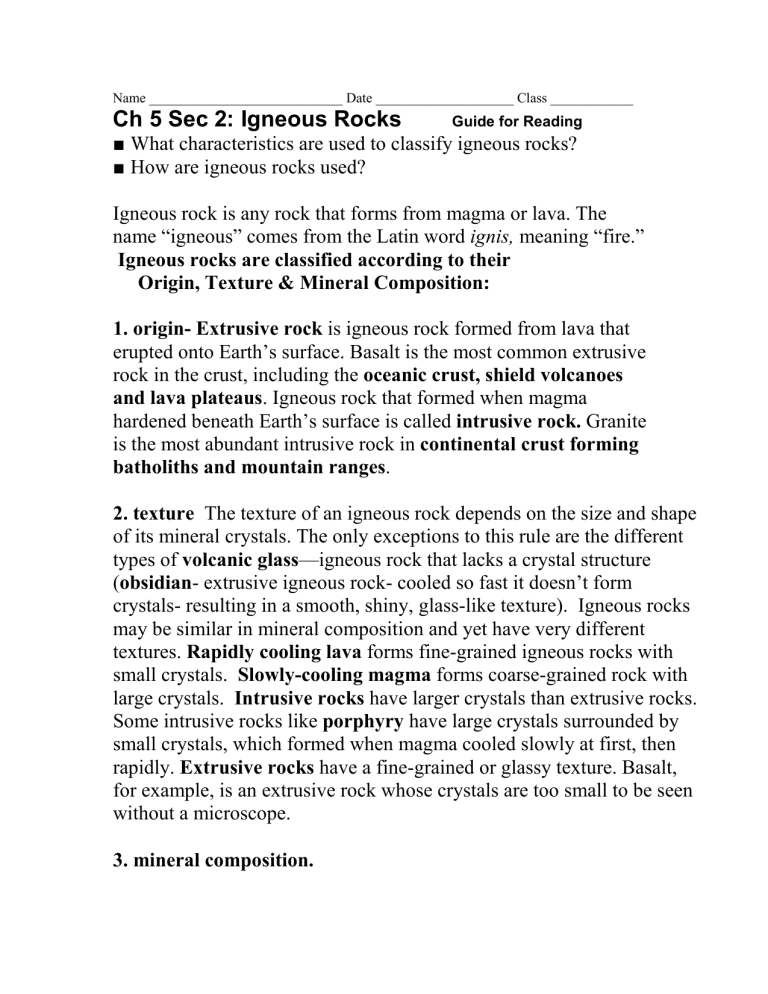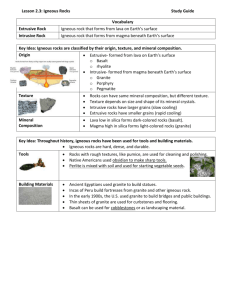Ch 5 Sec 2: Igneous Rocks Guide for Reading

Name ____________________________ Date ____________________ Class ____________
Ch 5 Sec 2: Igneous Rocks
Guide for Reading
■ What characteristics are used to classify igneous rocks?
■ How are igneous rocks used?
Igneous rock is any rock that forms from magma or lava. The name “igneous” comes from the Latin word ignis, meaning “fire.”
Igneous rocks are classified according to their
Origin, Texture & Mineral Composition:
1. origin- Extrusive rock is igneous rock formed from lava that erupted onto Earth’s surface. Basalt is the most common extrusive rock in the crust, including the oceanic crust, shield volcanoes and lava plateaus . Igneous rock that formed when magma hardened beneath Earth’s surface is called intrusive rock. Granite is the most abundant intrusive rock in continental crust forming batholiths and mountain ranges .
2. texture The texture of an igneous rock depends on the size and shape of its mineral crystals. The only exceptions to this rule are the different types of volcanic glass —igneous rock that lacks a crystal structure
( obsidian - extrusive igneous rock- cooled so fast it doesn’t form crystals- resulting in a smooth, shiny, glass-like texture). Igneous rocks may be similar in mineral composition and yet have very different textures. Rapidly cooling lava forms fine-grained igneous rocks with small crystals. Slowly-cooling magma forms coarse-grained rock with large crystals. Intrusive rocks have larger crystals than extrusive rocks.
Some intrusive rocks like porphyry have large crystals surrounded by small crystals, which formed when magma cooled slowly at first, then rapidly. Extrusive rocks have a fine-grained or glassy texture. Basalt, for example, is an extrusive rock whose crystals are too small to be seen without a microscope.
3. mineral composition.
The silica content of magma and lava can vary. Lava that is low in silica usually forms dark-colored rocks, such as basalt. Magma that is high in silica usually forms light-colored rock, such as granite.
Granite, however, comes in many shades and colors, from nearly black (hornblende, dark mica, quartz)) to light gray, red, and pink
(feldspar). The mineral composition of granite determines its color.
To identify the minerals, scientists make thin slices and study the rock’s crystals under a microscope.
Many igneous rocks are hard, dense, and durable. People throughout history have used igneous rock for tools and building materials.
Granite has a long history as a building material. Ancient
Egyptians used granite for statues. In the United States in the
1800s and early 1900s, granite was widely used to build bridges and public buildings and for paving streets with cobblestones.
Granite is still used in decorative stonework, curbstones, and
Floors.
Basalt is crushed to make gravel that is used in construction.
The rough surface of pumice makes it a good abrasive for cleaning and polishing.
Obsidian was used by ancient Native Americans to make sharp tools.
Perlite , formed from the heating of obsidian, is often mixed with soil for starting vegetable seeds.









